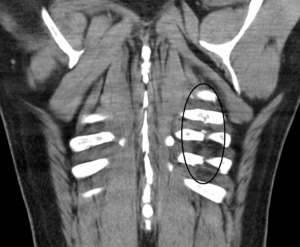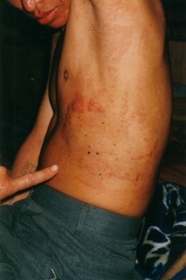Rib Injuries In BJJ: Causes, Diagnosis And Prevention
We all know injuries are part-and-parcel of combat sports training and competing. With the recent rib injury suffered by Tyron Woodley in his fight against Colby Covington, injuries to the ribs are in the spotlight. While Woodley’s ribs were broken during an MMA fight, rib injuries in BJJ are a frequent occurrence during both training and competition.
In this article, we break down some of the common rib injuries in grappling. We then go over some of the treatment strategies your doctor may prescribe. Finally, we will discuss some preventative measures you can take to avoid rib injuries altogether.
(Disclaimer: This article should not be considered medical advice. If you are injured, you should always seek care from a licensed medical doctor and physical therapist before beginning any treatment program.)
Common Rib Injuries In BJJ
Broken Ribs
Broken ribs are arguably the most severe rib injuries that can occur in BJJ.
According to the Mayo Clinic, a broken rib occurs when one of the bones in the rib cage ‘breaks or cracks.’ Typically this occurs due to direct impact trauma. In the case of BJJ, this could occur during a scramble or even due to excessive pressure from knee-on-belly.
A worst-case scenario in BJJ occurs when the rib shatters into multiple pieces. When this occurs, there is significant risk that a rib shard can damage a blood vessel or even vital organ, such as the lungs. The risk of organ damage increases with each rib that is broken. If organ damage occurs, you will likely end up in the hospital.
Symptoms of shattered ribs include severe pain when inhaling deeply, bending/twisting the torso, or pressing on the injured area. This type of injury requires immediate medical attention and will likely take months to fully heal.
Cracked Ribs
Cracked ribs are a less severe variation of completely broken ribs.
A cracked rib occurs through trauma to the rib cage that results in an incomplete fracture. With a cracked rib, there is far less risk of organ damage compared to a full shatter. Nevertheless, cracked ribs will still cause pain when inhaling deeply and moving the torso.
As with shattered ribs from BJJ, a cracked rib will be incredibly tender when pressed and will require a few months to fully heal. You may or may not require severe medical attention with a cracked rib. Either way, it’s always best to have a doctor check you out if you are experiencing any of the symptoms mentioned.
Bruised Ribs
Bruised ribs are the least severe rib injury, although they can still be painful. These injuries typically occur in the same way as broken or cracked ribs. The main difference is that the trauma is not sufficient to result in an actual fracture to the bone itself. Bruised ribs take a little less time to heal than a full-on fracture, but will still require some time-off from BJJ to fully heal.
Diagnosing BJJ Rib Injuries
The first sign of an injured rib will be one of the previously mentioned symptoms: area painful to the touch, pain with deep breathing and pain when moving the torso. An initial assessment by a medical doctor will involve these tests. From there, the doctor will decide whether to continue with imaging for comprehensive rib injury diagnosis.
Diagnosing the full extent of rib damage will require one or more of the following image tests:
X-ray
An X-ray image can assess whether there is a severe fracture, as well as diagnose severe damage to the lungs. Unfortunately, X-ray imaging may not fully reveal lesser fractures such as cracked ribs. X-rays may provide adequate imaging for fresh rib injuries.
CT Scan

A CT scan is a more comprehensive X-ray image that integrates multiple angles for better depiction of the internal structures. A CT scan can diagnose a BJJ rib injury that a standard X-ray can’t pick up.
MRI
MRI stands for Magnetic Resonance Imaging and uses a powerful magnet and radio waves to view damage to both bones and soft tissue structures. An MRI can reveal subtle fractures not visible on an X-ray or CT scan. Additionally, MRIs allow very detailed cross-sectional images of the body to assess the extend of organ or blood vessel damage.
Bone Scan
Bone scans involve injecting small amounts of radioactive material into your blood stream. The material collects in the bone tissues and allows very details imaging of bones. Bone scans can reveal subtle microfractures and repetitive trauma that have a relatively high likelihood of occurring during BJJ training.
Treating BJJ Rib Injuries
Treatment for rib injuries will depend on the extent of the damage. Generally speaking, broken ribs will require around six weeks of complete rest to fully heal. Icing and over-the-counter pain medication can help deal with any pain as the injury heals. For severe pain, your doctor may recommend a local pain injection.
If your rib is only bruised, the recovery time may be a bit quicker than a broken rib. According to Healthline, a bruised rib takes about a month to heal assuming you actually take time off.
Once the injury is recovered, your doctor may recommend breathing exercises. These are largely to ensure you are taking full, deep breaths, which reduce the risk of developing pneumonia.
Preventing Rib Injuries
Unfortunately, conventional medicine recommends “protecting yourself from contact injuries via protective gear” to avoid rib injuries. This is obviously not feasible in most BJJ scenarios. The best advice to directly avoid rib injuries would be ‘tap early, tap often.’ If you are a smaller guy or gal, you might consider avoiding excessively hard rolls with bigger partners.
In addition to acutely avoiding trauma, conventional wisdom recommends adequate calcium and vitamin D in your diet to ensure your bones are strong and healthy. Good strength and conditioning programs can help increase bone density, which may reduce the incidence of rib fracture.
Overall, contact injuries are inevitable in BJJ. While you can take measures to avoid them, there is no way to completely negate the risk of BJJ rib injuries.

